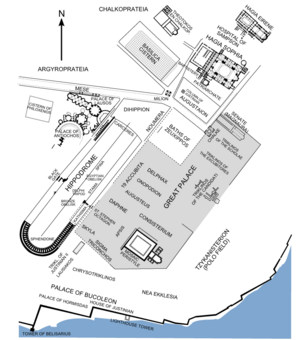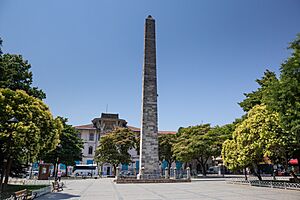Hippodrome of Constantinople facts for kids
Quick facts for kids Hippodrome |
|
|---|---|
| Sultanahmet Square (Sultanahmet Meydanı) | |
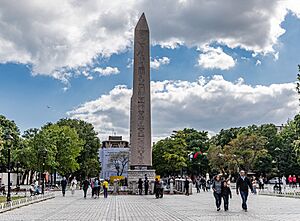
Obelisk of Theodosius in Sultanahmet Square today
|
|
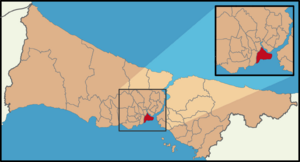 |
|
| Location | Istanbul, Turkey |
The Hippodrome of Constantinople was a huge stadium in the ancient city of Constantinople. This city was once the capital of the Byzantine Empire. Today, this area is a famous square in Istanbul, Turkey, called Sultanahmet Square.
The word hippodrome comes from two Greek words: hippos, meaning "horse," and dromos, meaning "path" or "way." So, it was basically a "horse path" or "horse track." In Turkish, it's sometimes called Atmeydanı, which also means "Horse Square." Horse racing and chariot racing were super popular sports in ancient times. Many Greek and Roman cities had their own hippodromes.
Contents
History and Use
Building the Hippodrome
Even though the Hippodrome is famous for its time in Constantinople, it was actually built much earlier. The first version was made when the city was called Byzantium. Back then, it was just a regular town.
In 203 AD, Emperor Septimius Severus rebuilt Byzantium. He made its walls bigger and added a hippodrome. This was an arena for chariot races and other fun events.
Later, in 324 AD, Emperor Constantine the Great decided to make Byzantium his new capital. He renamed it Nova Roma, meaning "New Rome." But people soon started calling it Constantinople, or "Constantine's City." Constantine made the city much larger. One of his biggest projects was making the Hippodrome even grander.
It's thought that Constantine's Hippodrome was about 450 meters (1,476 feet) long and 130 meters (426 feet) wide. The starting gates were at the north end. The curved seating area, called the sphendone, was at the south end. You can still see parts of this curved area today. In the middle of the race track was a barrier called the spina. This barrier was decorated with many cool monuments.
The stadium could hold an amazing 100,000 people! The race track was shaped like a "U." The emperor had his own special viewing box, called the Kathisma. It was on the eastern side of the track. The emperor and his family could go straight from the Great Palace of Constantinople to the Kathisma through a secret passage.
How the Hippodrome was Decorated
The Hippodrome was filled with incredible statues. There were statues of gods, emperors, animals, and heroes. Some famous ones included a statue of Heracles and one of Romulus and Remus with the she-wolf Lupa. The Serpent Column was also there.
On top of the starting gates, there were four golden copper horse statues. These are now known as the Horses of Saint Mark. No one is quite sure if they were originally Greek or Roman. They were taken during a war in 1204 and are now on a church in Venice. The race track also had bronze statues of famous horses and chariot drivers, but none of those exist anymore.
Emperor Constantine Porphyrogenitus wrote about the Hippodrome's decorations. He mentioned purple hangings and rare tapestries used for special visitors.
What Happened at the Hippodrome
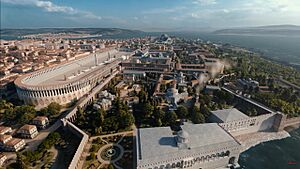
During the Byzantine Empire, the Hippodrome was the most important social spot in the city. People bet huge amounts of money on chariot races. There were usually four main teams, each supported by a different group of citizens. These groups were called the Blues, the Greens, the Reds, and the Whites. Over time, the Reds and Whites joined the Blues and Greens.
Up to eight chariots raced at a time, with each chariot pulled by four horses. These races were more than just sports. They were one of the few times the emperor and regular people could be in the same place. Important political talks often happened at the Hippodrome. The emperor could even go directly from his palace to his special box there.
The competition between the Blues and Greens was intense. It often mixed with political or religious disagreements. Sometimes, these rivalries led to big riots, almost like civil wars. The worst riot was the Nika riots in 532 AD. About 30,000 people died, and many important buildings were destroyed. This included the Hagia Sophia, which was the city's main church. After the riots, Emperor Justinian I built the current (third) Hagia Sophia.
The Hippodrome's Decline
Constantinople never fully recovered after it was attacked and looted during the Fourth Crusade in 1204. Even though the Byzantine Empire lasted until 1453, the Hippodrome slowly fell apart. The Venetians, who were involved in the Fourth Crusade, likely took the famous four horse statues from the Hippodrome.
When the Ottoman Empire took over the city in 1453, their Sultan Mehmed II wasn't interested in chariot racing. The Hippodrome was gradually forgotten. It was never completely built over, but people used its stones for other buildings.
Hippodrome Monuments
The Serpent Column
To make his new capital look grand, Emperor Constantine and later emperors, like Theodosius the Great, brought amazing artworks from all over the empire. These monuments were placed in the middle of the Hippodrome, on the spina.
One of these was the Serpent Column. It was made to celebrate the Greek victory over the Persians in the Battle of Plataea way back in the 5th century BC. Constantine ordered it moved from the Temple of Apollo in Delphi. The top of the column originally had a golden bowl held up by three serpent heads. It seems this golden bowl never made it to Constantinople. The serpent heads and the top part of the column were broken in 1700. Parts of the heads were found later and are now in the Istanbul Archaeology Museum. Today, only the base of the column remains.
The Obelisk of Thutmose III

Another emperor who decorated the Hippodrome was Theodosius the Great. In 390 AD, he brought a tall, pointed stone pillar called an obelisk from Egypt. He set it up inside the race track.
This obelisk is made of pink granite. It was first put up at the Temple of Karnak in Luxor around 1490 BC by Pharaoh Thutmose III. Theodosius had the obelisk cut into three pieces to move it to Constantinople. The top section is what you see today. It stands exactly where Theodosius placed it, on a marble base. This granite obelisk has lasted for nearly 3,500 years and is still in great shape!
The Walled Obelisk
In the 10th century, Emperor Constantine Porphyrogenitus built another obelisk at the other end of the Hippodrome. This one was once covered with shiny gilded bronze plates. But these plates were stolen by soldiers during the Fourth Crusade. The stone core of this monument is still there today and is known as the Walled Obelisk.
Statues of Porphyrius
Seven statues were placed on the Spina of the Hippodrome to honor Porphyrius the Charioteer. He was a legendary chariot driver in the early 6th century. He raced for both the "Greens" and the "Blues" teams. None of these statues have survived. However, the bases of two of them are still around and are displayed in the Istanbul Archaeological Museum.
The Hippodrome Today
The area where the Hippodrome once stood is now officially called Sultanahmet Square. The Turkish government takes care of it. You can see the outline of the old race track marked out with paving stones. The actual track is about 2 meters (6.5 feet) below the current ground level.
The monuments that are left from the Spina—the two obelisks and the Serpent Column—are now in special excavated pits within a beautiful garden.
At the northern entrance to the Hippodrome area, right in front of the Blue Mosque, is the German Fountain. It's an octagonal fountain with a dome, built in a style similar to old Byzantine buildings. The German government built it in 1900 to remember the visit of German Emperor Wilhelm II to Istanbul in 1898.
Archaeologists have done some digging at the Hippodrome site. In the 1980s, parts of the curved seating area (the sphendone) became more visible. In 1993, when an area near the Blue Mosque was being prepared for a new building, several rows of seats and columns from the Hippodrome were found. These pieces were moved and can now be seen in Istanbul's museums. It's possible that many more parts of the Hippodrome are still hidden beneath the parkland of Sultanahmet Square.
The Hippodrome was even featured on the back of Turkish 500 lira banknotes from 1953 to 1976!
Images for kids
-
The four bronze horses that were once on top of the Hippodrome's boxes. Today, they are at St Mark's Basilica in Venice.
-
The base of the Obelisk of Thutmose III showing Emperor Theodosius giving a laurel wreath to a winner from the Kathisma at the Hippodrome.
-
The Grand Vizier Crossing the Atmeydanı by Jean Baptiste Vanmour shows the Hippodrome and the Blue Mosque in the early 17th century.
-
A watercolor painting of the Hippodrome's spina and Hagia Sophia from an old manuscript.


